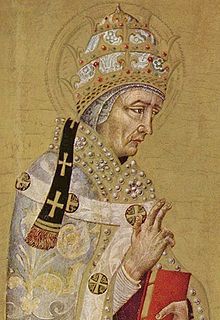
There have been 110 papal elections that have produced popes currently recognized by the Catholic Church as legitimate. There was no fixed process for papal succession before 1059 and popes were often selected with substantial secular involvement, if not outright appointment. Since the promulgation of In nomine Domini (1059), however, suffrage has been limited to the College of Cardinals. [1]

The Catholic Church, also known as the Roman Catholic Church, is the largest Christian church, with approximately 1.3 billion baptised Catholics worldwide as of 2017. As the world's "oldest continuously functioning international institution", it has played a prominent role in the history and development of Western civilisation. The church is headed by the Bishop of Rome, known as the Pope. Its central administration, the Holy See, is in the Vatican City, an enclave within the city of Rome in Italy.

There was no fixed process for papal selection before 1059. Popes, the bishops of Rome and the leaders of the Catholic Church, were often appointed by their predecessors or secular rulers. While the process was often characterized by some capacity of election, an election with the meaningful participation of the laity was the exception to the rule, especially as the popes' claims to temporal power solidified into the Papal States. The practice of papal appointment during this period would later give rise to the jus exclusivae, a veto right exercised by Catholic monarchies into the twentieth century.

The pope, also known as the supreme pontiff, is the Bishop of Rome and ex officio leader of the worldwide Catholic Church. Since 1929, the pope has also been head of state of Vatican City, a city-state enclaved within Rome, Italy. The current pope is Francis, who was elected on 13 March 2013, succeeding Benedict XVI.
Contents
Papal elections since 1276 have taken the form of papal conclaves, which are elections that follow a set of rules and procedures developed in Ubi periculum (1274) and later papal bulls; observance of the conclave varied until 1294, but all papal elections since have followed relatively similar conclave procedures.

A papal conclave is a meeting of the College of Cardinals convened to elect a Bishop of Rome, also known as the pope. The pope is considered by Roman Catholics to be the apostolic successor of Saint Peter and earthly head of the Roman Catholic Church.
Ubi periculum is a papal bull promulgated by Pope Gregory X during the Second Council of Lyon on 7 July 1274 that established the papal conclave format as the method for selecting a pope, specifically the confinement and isolation of the cardinals in conditions designed to speed them to reach a broad consensus. Its title, as is traditional for such documents, is taken from the opening words of the original Latin text, Ubi periculum maius intenditur, 'Where greater danger lies'. Its adoption was supported by the hundreds of bishops at that council over the objections of the cardinals. The regulations were formulated in response to the tactics used against the cardinals by the magistrates of Viterbo during in the protracted papal election of 1268–1271, which took almost three years to elect Gregory X. In requiring that the cardinals meet in isolation, Gregory was not innovating but implementing a practice that the cardinals had either adopted on their own initiative or had forced upon them by civil authorities. After later popes suspended the rules of Ubi periculum and several were elected in traditional elections rather than conclaves, Pope Boniface VIII incorporated Ubi periculum into canon law in 1298.

A papal bull is a type of public decree, letters patent, or charter issued by a pope of the Roman Catholic Church. It is named after the leaden seal (bulla) that was traditionally appended to the end in order to authenticate it.
Although the cardinals have historically gathered at a handful of other locations within Rome and beyond, only five elections since 1455 have been held outside the Apostolic Palace. [2] Twenty-eight papal elections have been held outside Rome, in: Terracina (1088), Cluny (1119), Velletri (1181), Verona (1185), Ferrara (October 1187), Pisa (December 1187), Perugia (1216, 1264–1265, 1285, 1292–1294, 1304–1305), Anagni (1243), Naples (1254, 1294), Viterbo (1261, 1268–1271, July 1276, August–September 1276, 1277, 1281–1282), Arezzo (January 1276), Carpentras/Lyon (1314–1316), Avignon (1334, 1342, 1352, 1362, 1370), Konstanz (1417) and Venice (1799–1800). Three elections moved between locations while in progress: the elections of 1268–71, 1292–94, and 1314–16.

The Apostolic Palace is the official residence of the pope, the head of the Catholic Church, located in Vatican City. It is also known as the Papal Palace, the Palace of the Vatican and the Vatican Palace. The Vatican itself refers to the building as the Palace of Sixtus V, in honor of Pope Sixtus V, who built most of the present form of the palace.

Terracina is a city and comune of the province of Latina -, Italy, 76 kilometres southeast of Rome by rail and 56 kilometres (35 mi) by the Via Appia by car.

Cluny is a commune in the eastern French department of Saône-et-Loire, in the region of Bourgogne-Franche-Comté. It is 20 km (12 mi) northwest of Mâcon.



















